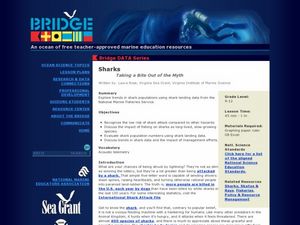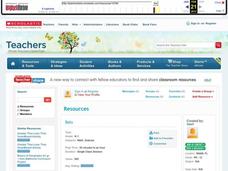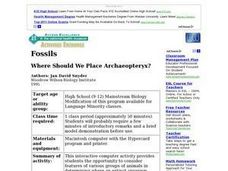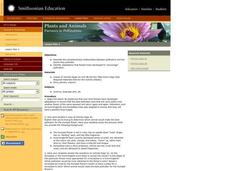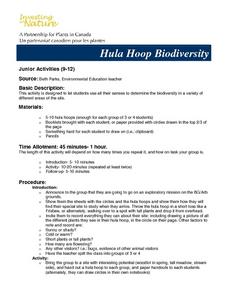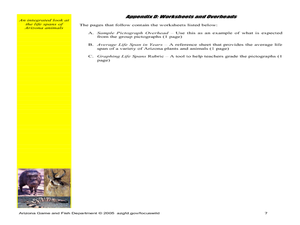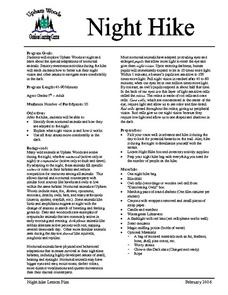Curated OER
Sharks ~ Taking a Bite Out of the Myth
The first thing to know about this lesson is that the commercial fisheries data for the activity no longer seems to be available. That being said, there are fascinating links to other websites, some about the comparative odds of being...
Curated OER
Wildlife Conservation III
Discuss the importance of wildlife conservation. Learners talk about the animals and plants on the US Fish and Wildlife Services list of endangered and threatened species. Then, they engage in a detailed discussion of the reasons these...
Curated OER
Bat and Moth
Learners stand in a circle, with two in the center. The center students are the bat and moth. They are both blindfolded, and the bat must catch the moth. The bat shakes a can, and the moth must reply by shaking his/her can, also. After...
Curated OER
Bats
Students investigate bats. In this animal science lesson, students use several websites and suggested bat books to write an informative paragraph. Students should be able to write with 90% accuracy.
Curated OER
Pond Animals During The Seasons
Students interact with a CD Rom to examine pond life. In this pond life lesson, students access a CD Rom entitled "Sammy's Science House CD Rom" in order to see pond life during the different season of the year. They study the associated...
Curated OER
Animals Abound Pre/Post Assessment
Students prepare for or evaluate their experiences in learning about animal persistence. This is part of a multi-segmented unit on animal living, adaptation, and survival.
Curated OER
Where Should We Place Archaeopteryx?
Pupils classify Archaeopteryx using pictures of actual fossils and scientist representations of how the animal might have looked. They compare Archaeopteryx's characteristics to those of the five extant vertebrate groups to...
Curated OER
Hare and Lynx Population
Fourth graders study changes in animal population. For this graphing lesson, 4th graders create graphs from information read to them about hares and lynx populations. They will describe patterns of change in the graphs and discuss why...
Curated OER
Talking Duck
Students visit a local wetland or WWT centre and record their observations by writing or drawing on the downloadable pupil activity sheet.
Curated OER
A Tasty Experiment
Students work together to determine if smell is important to being able to recongize food by taste. They try different foods with different textures and hold their nose. They create a graph of their results.
Curated OER
Horns or Antlers-You Decide!
Students study the difference between horns and antlers. They identify animals who have each and draw pictures of these animals. They experience samples of actual horns and antlers.
Curated OER
Plants and Animals: Partners in Pollination
Students describe the complementary relationships between pollinators and the plants they pollinate, identify adaptations that flowers have developed to "encourage" pollination, and create and draw their own "designer" flowers.
Curated OER
How Evolution Works
Students discuss the evolution of the eye and how a complex organ can evolve through natural selection. They research genetic variation, adaptation, and sexual selection. They analyze data to determine how beak length of Gal??pagos...
Curated OER
Pets: Oh Behave
Young scholars develop an understanding of how innate and learned behaviors and the environment determine behavior. They see how a variety of factors affects our pet's behavior-including species-specific traits, the environment,...
Curated OER
A Campfire Conversation
Students examine point of view as it relates to public issues. In this point of view instructional activity, students become familiar with the point of view of John Muir and Theodore Roosevelt about the wilderness. Students debate...
Curated OER
Hula Hoop Biodiversity
Students determine the biodiversity in a variety of different areas. They record everything they can about their site- including drawing a picture of all the different plants they see in their hula hoop, in the circle on their page.
Curated OER
Deer Tracks
Young scholars use satellite images to track to movement patterns of deer and examine deer behavior. They write stories about a day in the life of a field scientist.
Curated OER
Where Have All the Endangered Gone?
Students explore animals that are endangered. They choose an endangered animal that they would like to keep from becoming extinct. Students create a persuasive presentation to persuade someone to understand why they feel keeping their...
Curated OER
Charting Animal Life Spans
Second graders research animal life spans and complete related math activities. In this life span lesson, 2nd graders read How Many Candles and discuss life spans. Students arrange animal cards based on their life spans. Students find...
Curated OER
Value: Love, Topic: Friendship
Sixth graders participate in a skit, "Henry Gets it Right." They discuss the skit and qualities of a friend. They discuss an example of a wild animal taking care of animals of a different species. They consider the behavior versus the...
Curated OER
Would You Believe Your Eyes?
Students study the parts and functions of the human eye. They create dodecagons which are twelve-sided figures with twelve equal angles and share these with the class so that each student can begin to see how many different illusions can...
Curated OER
Night Hike
Learners explore Upham Woods at night and investigate about the special adaptations of nocturnal animals. They identify three nocturnal animals and how they are adapted to the night. Students explain what night vision is and how it works.
Curated OER
Cranes, Crosswalks, and Big Gulps
Students watch a video and answer questions based on wildlife jobs. In this wildlife lesson plan, students learn that biologists don't just play with animals but that there is a lot of study involved.
Curated OER
Oil Spill Dangers
Students analyze the effects of oil spills on our environment and develop action plans to protect animals and habitats.
